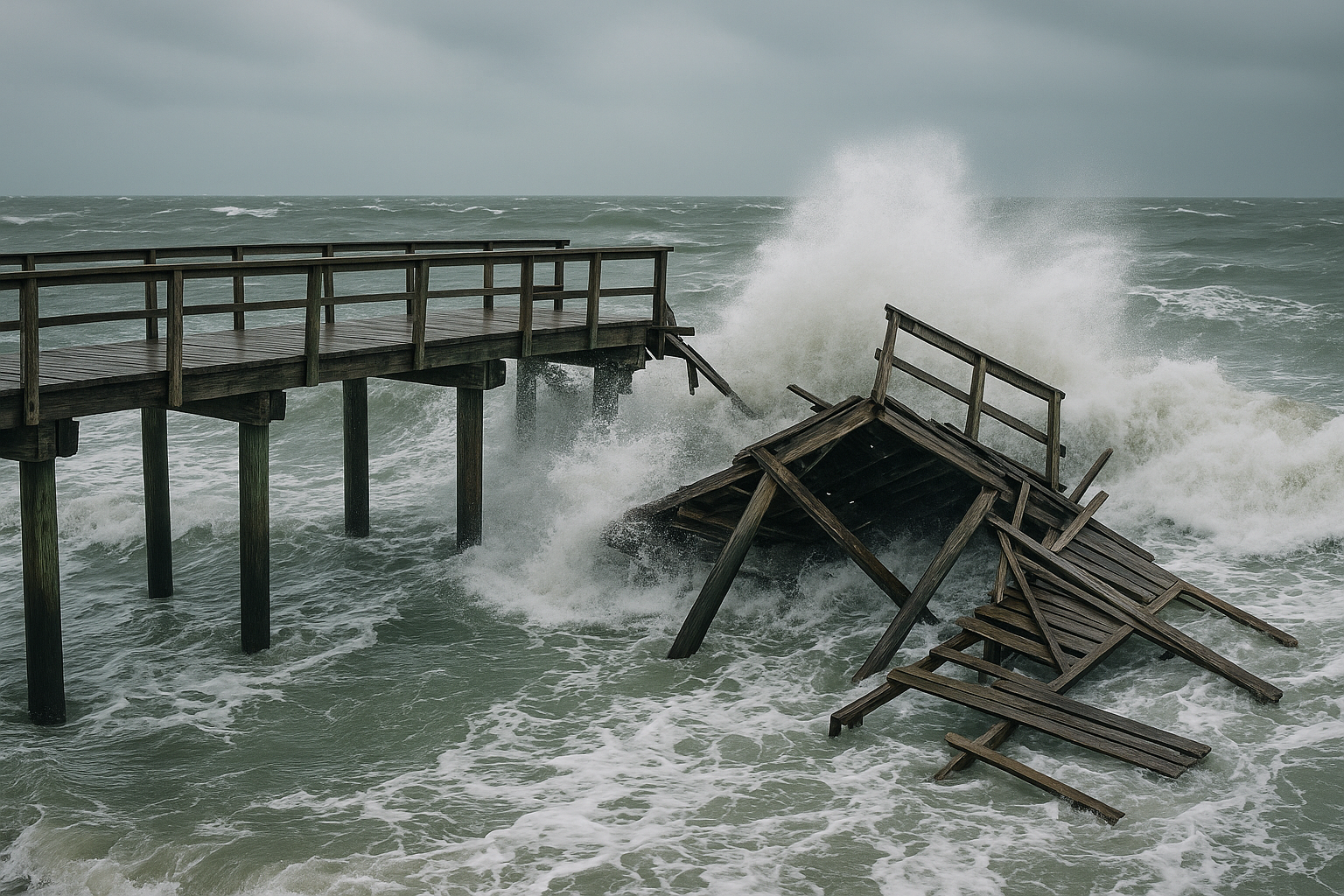Dock and Bulkhead Maintenance Overview
Why Seasonal Maintenance Matters
Keeping your docks and bulkheads in good shape means doing seasonal maintenance. Ignoring these structures can lead to pricey fixes and unsafe conditions. Every season brings its unique challenges, and tackling these upfront can save you a lot of time and cash.
Just last summer, a marina owner I know talked about how regular maintenance helped catch problems early. Before work started for the season, they found some wood on their bulkhead was rotting from too much moisture. Because they spotted it in time, they could swap it out before it turned into a bigger problem.
Here are a few solid reasons why seasonal maintenance is a big deal:
- Preventing Damage: Fixing small issues early helps avoid more severe problems down the road, keeping everything safe and sound.
- Saving Money: Regular check-ups can help you avoid big repair bills by spotting issues before they escalate.
- Boosting Safety: A well-kept dock or bulkhead cuts down on hazards, lowering the risk of accidents and injuries.
So, seasonal maintenance isn’t just about how things look. It’s a smart way to keep everything sturdy and let everyone have a great time enjoying the waterfront.
Inspection Checklist
Checking Dock Condition Visually
Once you start seasonal maintenance, the first thing to do is take a good look at the dock. This simple inspection can tell you a lot—like if the wood has changed color, if there’s mold, or any wear and tear. I remember my friend’s dock looked fine until we looked closer and found some serious discoloration and slippery spots from algae.
While you’re inspecting, keep an eye out for:
- Cracks or Splits: These can make things worse over time.
- Warping or Bending: See if any boards are out of place.
- Signs of Rot: This could mean there’s a bigger issue lurking below.
Checking Structural Integrity
Next up is making sure the structure is solid. This helps confirm your dock can handle the weight and weather. I remember helping my uncle check his bulkhead on a windy day. We found some loose posts that could have given way under pressure.
Key things to look at include:
- Posts and Pilings: Make sure they’re secure and not decaying.
- Joists: Check for any sagging.
- Decking Stability: Step on it to see if it feels soft, which could mean rot.
Checking Hardware and Fasteners
Lastly, take a look at the hardware and fasteners. These little parts are critical in keeping everything intact. Ignoring them can cause major issues.
When checking the hardware, think about:
- Corrosion: Rust can weaken bolts and screws.
- Loose Fasteners: Tightening them regularly can help prevent issues.
- General Wear: Swap out any parts that look worn to keep things running smoothly.
With this handy checklist, you can keep your dock safe and functional for everyone who wants to enjoy the water without worry.
Cleaning and Restoration
Clearing Debris and Algae
After your inspection, it’s cleaning time. A tidy dock not only looks great but also helps prevent damage. Start by clearing away leaves, sticks, and any trash that piled up over time. A buddy of mine discovered a little plant paradise blooming in the corners of his dock; while it was pretty, it wasn’t good for the surface.
For getting rid of algae:
- Use a Long-Handled Scrub Brush: This helps you reach tricky spots without straining.
- Natural Cleaners: Think about eco-friendly choices like vinegar or baking soda to keep things green.
Pressure Washing Tips
Once you’ve cleared the debris, pressure washing is a total game-changer. It wipes out tough stains and built-up grime that can cause damage to your dock. One maintenance day with my family, we rented a pressure washer, and it was incredible—our dingy dock looked brand new!
Here are some tips for pressure washing:
- Adjust the Pressure: Use low settings on softer woods to avoid damage.
- Keep Your Distance: Stay a safe distance away from the surface to prevent gouging.
Repainting and Staining
After cleaning, think about giving it a fresh coat of paint or stain for extra protection. It makes the dock look better and fights off elements.
When picking products, look for:
- Water-Resistant Paints: Good at keeping moisture out.
- Natural Wood Stains: Let the wood’s beauty shine while protecting it.
By systematically cleaning and restoring your dock, you’ll not only extend its life but also make sure it stays a safe and pleasant spot for everyone who uses it.
Repairs and Upgrades
Common Repair Techniques
After cleaning and inspecting, it’s time to tackle any repairs you need to make. Regular check-ups often highlight problems that need urgent fixing. For example, during my last check, I found a couple of loose boards that were at risk of splintering. Thankfully, tightening them was super easy!
Common repair methods include:
- Switching Out Damaged Boards: If any boards are cracked or rotten, you need to replace them.
- Strengthening Loose Parts: Make sure to tighten loose bolts and screws; if needed, add more fasteners for extra support.
- Filling in Gaps: Use wood filler to patch up small holes or cracks before you repaint or seal.
Upgrading Materials for Longevity
While you’re making repairs, think about upgrading materials for better durability. Choosing the right stuff can handle tough weather and heavy use. A while back, I switched to composite decking during a redesign, and it’s been way tougher and needs less maintenance than regular wood.
Here are some materials to consider:
- Composite Decking: This is resistant to rot and bugs, making it a solid choice for lasting power.
- Marine-Grade Fasteners: These handle salty air and moisture better, keeping rust and deterioration at bay.
Boosting Looks and Function
Repairs are also a great time to think about adding some flair. Improving both the look and function can change the dock experience. For instance, my neighbor put LED lights along their dock, creating a nice vibe and safety for nighttime outings.
Consider these upgrades:
- Non-Slip Surfaces: This makes things safer, especially when it’s wet.
- Storage Solutions: Install built-in benches or racks to keep gear tidy and organized.
By focusing on effective repairs and upgrades, dock owners can create a safe, appealing, and long-lasting space for all kinds of water fun.
Safety and Compliance
Knowing Local Regulations
As you kick off your dock maintenance, it’s super important to understand safety and compliance. This starts with knowing your local rules about dock upkeep and safety. I found this out the hard way when I launched into a renovation only to realize it clashed with zoning laws. Always check what your area requires. This may include needing permits for repairs and improvements.
You can often find helpful info through:
- Local Government Websites: These usually offer guidelines and contact details for more help.
- Marina Associations: These groups can provide specialized resources related to dock regulations.
Safety Practices During Maintenance
Safety is key in any maintenance effort. Whether you’re working alone or in a group, following good safety practices helps reduce risks a lot. Last spring, while I was fixing my friend’s bulkhead, we made sure to wear protective gear and stick to safety protocols.
Must-have safety measures include:
- Personal Protective Equipment (PPE): Always use gloves, safety glasses, and non-slip shoes.
- Ladder Safety: Check ladders for stability, and don’t go over the weight limit.
- Clear the Workspace: Make sure the area is free of debris to avoid slips and falls.
Hiring Professionals
Sometimes, it’s best to bring in the pros for complicated jobs or if you’re unsure about certain repairs. A coworker of mine had a great experience with a company that did dock repairs and followed all safety rules.
When looking to hire pros, keep these points in mind:
- Check Their License and Insurance: Make sure they are licensed and have good insurance coverage.
- Look at References and Reviews: Checking customer feedback will help you judge their reliability.
- Get Detailed Estimates: Request written quotes for clarity on costs and work scope.
By prioritizing safety and compliance, you’re setting up a maintenance plan that not only works but keeps everyone safe enjoying your waterfront area.
Seasonal Tips
Getting Ready for Spring Weather
As the seasons shift, so do the needs of your dock and bulkhead. Spring is a fresh start, but it also brings its set of challenges with melting snow and more rain. I remember my first spring with a dock; I had no clue how the water flow would reveal problems I hadn’t noticed before.
To prep for spring weather, here are some things to do:
- Check Drainage: Make sure your drainage systems are clear to stop water from pooling.
- Look for Ice Damage: After things thaw, check for any structural harm ice may have caused.
- Check Stability: Look over supports and mooring lines because spring storms can be pretty fierce.
Winter Prep Tips
It’s also vital to prep your dock for winter to protect it during the cold season. I learned this when harsh winters damaged my neighbor’s dock that had been neglected.
Key winter prep tips are:
- Take Down Seasonal Structures: Remove anything temporary like floating docks or furniture to avoid ice damage.
- Store Equipment Safely: Clean and put away all boating gear inside to keep it from getting ruined by the weather.
Regular Maintenance During the Season
Lastly, consistent upkeep during the season is key to making things last. Regularly check for any wear and tear, especially after nasty storms. After a particularly rainy week, a neighbor found a bunch of algae growing on their dock that needed immediate attention.
To keep your dock in check:
- Do Regular Inspections: Monthly checks for cracks, mold, and loose fasteners can keep you ahead.
- Schedule Cleanings: Regular cleanings help keep things safe and looking good.
- Plan for Seasonal Upgrades: If you notice any wear, think about upgrading materials to make things more durable.
By keeping these seasonal tips in mind, dock owners can look forward to a safe and useful space year-round, ready for loads of water fun.
Wrapping Up
Recap of Key Maintenance Steps
As we finish our chat about dock and bulkhead maintenance, it’s important to remember the key steps to keep them lasting and safe. Start with a detailed inspection to evaluate the condition, then follow up with thorough cleaning and restoration.
To summarize:
- Inspection Checklist: Do visual checks, structural assessments, and hardware evaluations.
- Clean and Restore: Clear debris and algae, pressure wash surfaces, and consider repainting or staining.
- Handle Repairs and Upgrades: Fix damages with common repair techniques and look into better materials for lasting durability.
- Safety and Compliance: Know local rules and take necessary safety steps when you do maintenance.
I still remember how relieved I felt addressing these crucial steps before our summer get-togethers at the dock; it brought me priceless peace of mind.
Encouragement for Proactive Care
Taking charge of your dock maintenance not only improves safety but also lets you enjoy your space fully. It’s way easier to prevent troubles than to deal with expensive repairs later. I really encourage everyone to see these tasks as a solid investment in your property and the fun that comes with it.
If you keep to these tips and dedicate some time throughout the year, you’ll ensure a functional, safe, and inviting dock for your family and friends. So get your hands dirty—you’ll be glad you did!

